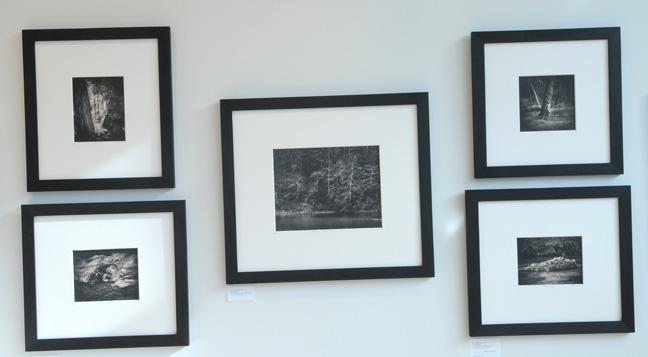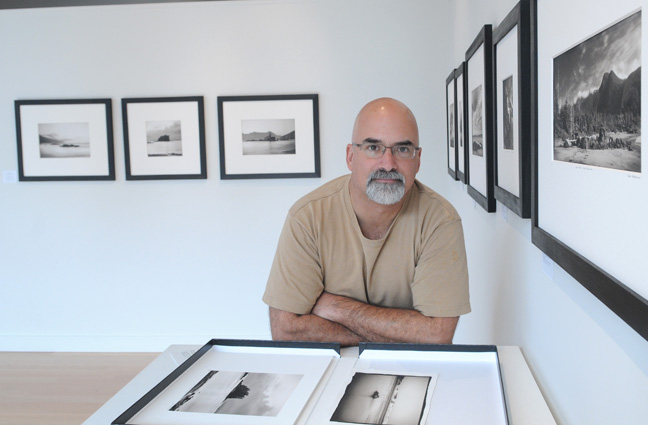1) Give us a brief biography.
I’m from Toronto originally. I moved to Victoria in 1991 to do my grad studies in geography at Uvic. After a brief career as a civil servant (4 years working for the Ministry of Environment) I quit and attended the Western Academy of Photography. I then moved to Vancouver where I did assisting work and began my own photography business.
2) Is it safe to say that architectural photography is your vocation while your fine art is your inspiration?
Yes, although I am also inspired when I get to photograph interesting architecture. My commercial work is mostly architectural and I’ve made a division between that and my Fine-Art work, but I shoot architecture because I’m fascinated by it, not just because its a way to make money.
3) What’s the attraction of architectural photography?
I’ve always been inspired by how we use and occupy space. I believe we are far more affected by the physical space we occupy on a day to day basis than we realize. When I get to see interesting architecture then try to interpret it photographically, I’m a very happy camper! I like the challenge of shooting architecture too. Some people think its boring, but I’m fascinated with how to make a building look its best. You need to look at the natural light on the outside as well as how the interior space uses both natural and artificial light. It presents a number of logistical challenges that I enjoy solving.
4) You present your fine art work as platinum/palladium prints as well as digital prints. What is involved in the platinum/palladium process?
Platinum printing is a very old method of making black & white prints, preceding traditional silver prints. It involves hand-coating paper with an emulsion containing platinum and/or palladium metals along with ferric oxalate which sensitives it to UV light. This is a contact printing process so I scan my film then create a new digital negative in the size I wish to print. This negative is then placed over the dried emulsion on the paper and exposed to UV light. The print is then developed and rinsed. Its a labour-intensive method btu I love the tonal range and overall appearance of platinum prints. They match the vision I’ve always had for my b&w photographs which I’ve been unable to achieve in any other way.

5) What do you do to produce your digital prints?
If I make a digital print, I’m usually trying to emulate the look of a platinum print. I do like digital printing especially because of the variety of beautiful papers we have to print on now. In general, I print on anEpson 3800 printer using a variety of both matte and glossy papers. I tend to warm-tone my prints which is the way I like my b&w to look.
6) What came first landscapes or nudes?
I was first drawn to photography so I could shoot the landscape. I’be been doing that since I was a teenager. It was only about 10 years ago that I began photographing the nude and it has taken some time to develop a coherent way in which to move forward with this work.
7) Have you always incorporated your nudes into a landscape?
Initially I didn’t necessarily shoot nudes in the landscape. Even now, I still shoot some nudes indoors but this is a small area of my work. My primary nude work is a series of nudes in the rainforest that I’ve been working on for several years now.
8) Do you use pro models or amateurs? Why?
I’ve worked with both, but in general, I tend to work with professional models. This is largely because My goal is to publish and exhibit these photographs. Models need to be okay with having their images shown this way, which sometimes amateurs models are not. I’ve also been extremely fortunate to work with a number of models that share my vision for the nudes I shoot. This makes it more of a collaborative process which always results in much better photographs.
9) What is it about the west coast landscape that fascinates you?
When I moved to the Island from Toronto I knew I’d never leave the coast. The coastal landscape inspires me in numerous ways. I do lots of sea kayaking and have paddled the entire BC coast from Prince Rupert to Victoria. The coastal landscape is an amazing place. Its surprisingly varied and can be both incredibly beautiful and also terrifying at the same time. From warm summer days to deep winter storms the coast provides me with an amazing canvas to work with. Its also surprisingly difficult to photograph, which makes for a very interesting challenge.
10) You often photograph in remote areas where extreme weather and wildlife are abundant. What is the greatest challenge when you’re out photographing your landscapes?
Probably just getting there is the biggest challenge. My favourite place in the world is the Brooks Peninsula on the northwest coast of the island. Its accessible only by boat and its a desolate and remote location. Kayaking to these places means packing all my gear into a small boat and sometimes paddling for days to get to certain places.
11) What photographer’s work do you look to for inspiration?
That’s a tough one. I grew up looking at Ansel Adams and Edward Weston’s works. Other people such as Wynn Bullock, Minor White and Sally Mann have provided great inspiration. I admit, nowadays I don’t look at a lot of other photographs for inspiration. Lately I’ve been shooting as much as I can to refine my own process and I’ve been finding that pushing myself to refine my vision and technique has itself been a great source of inspiration.
12) What advice can you give to the aspiring landscape or nude fine art photographer?
Shoot as much as you can. Be ruthless in editing your work. Shoot film.
You can find more of Dave’s work at www.daveaharonian.com



Comment 1